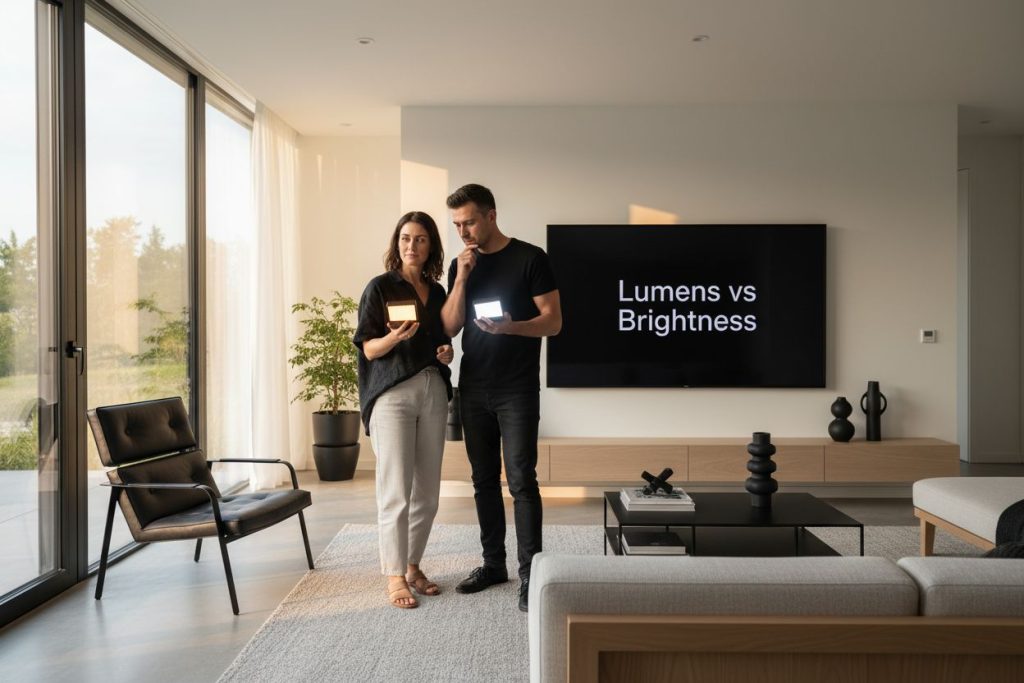Most people think picking the right light is as simple as choosing the brightest option. Yet a light source with 2,000 lumens can look completely different depending on where you use it. Here's the surprise. Brightness is not just about the number on the box, but how your eyes, your space, and even your mood interpret that glow. This difference can make or break your visual comfort in ways most never consider.
Table of Contents
- What Are Lumens And Brightness?
- Why Lumens Matter In Lighting Choices
- How Brightness Affects Visual Comfort
- Key Differences Between Lumens And Brightness
- Practical Applications Of Lumens In Home Entertainment
Quick Summary
| Takeaway | Explanation |
|---|---|
| Understand lumens for light output | Lumens quantify visible light emitted, with higher values indicating brighter sources. This helps in choosing effective lighting. |
| Brightness perception varies by context | Brightness is subjective, influenced by surrounding light, surface colors, and individual viewing conditions, impacting visual experiences. |
| Select lighting based on room needs | Different environments require specific lumen outputs; for instance, large spaces need more lumens for clear visibility than smaller rooms. |
| Higher lumens enhance energy efficiency | Choosing lights with optimal lumen ratings over watts ensures better illumination while reducing energy usage and costs. |
| Aim for balanced brightness for comfort | Properly managed brightness enhances visual comfort and cognitive function, reducing fatigue and promoting concentration. |
What Are Lumens and Brightness?
Understanding the nuanced relationship between lumens and brightness is crucial for selecting the right lighting or projection equipment. While these terms are often used interchangeably, they represent distinct technical measurements that significantly impact visual performance.
Defining Lumens: The Measurement of Light Output
Lumens represent the total amount of visible light emitted by a source, serving as a standardized metric for quantifying light output. Think of lumens as the raw amount of light produced, much like how horsepower measures an engine's potential power. For projectors and lighting systems, higher lumen ratings indicate greater light generation capacity.
Key Characteristics of Lumens:
- Measures total light output
- Represents the quantity of visible light emitted
- Applies universally across different light sources
- Directly correlates with perceived brightness potential
In practical terms, a projector with 2,000 lumens will appear brighter than one with 1,000 lumens under similar environmental conditions. Learn more about understanding ANSI and lumens measurements to gain deeper technical insights.
Understanding Brightness: Perception and Context
Brightness, unlike lumens, is a subjective perception of light intensity influenced by multiple factors beyond raw light output. It depends on variables such as ambient light, surface reflectivity, color temperature, and human visual perception. Two light sources with identical lumen ratings might be perceived differently based on surrounding conditions.
Factors Influencing Perceived Brightness:
- Ambient environmental lighting
- Surface color and reflectivity
- Viewing angle and distance
- Individual eye sensitivity
According to lighting research from the Illuminating Engineering Society, brightness perception is complex and cannot be determined by lumens alone. Professional lighting designers and AV specialists understand that effective visual performance requires comprehensive analysis beyond simple numerical measurements.
While lumens provide a standardized metric for light output, brightness remains a nuanced, context-dependent experience that combines technical specifications with human perceptual dynamics.
Why Lumens Matter in Lighting Choices
Selecting the right lighting involves more than aesthetic preferences. Lumens play a critical role in determining the effectiveness and efficiency of lighting solutions across various environments, from home theaters to professional presentation spaces.
Matching Light Output to Space Requirements
Understanding lumen requirements helps you select lighting that provides optimal illumination without wasting energy. Different spaces demand different light intensities. A small home office might require 300-500 lumens, while a large conference room could need 1,500-2,000 lumens for clear visibility.
Critical Considerations for Space Illumination:
- Room size and dimensions
- Intended activity and visual tasks
- Existing ambient light conditions
- Desired visual comfort and clarity
Explore projector lumens guide for Malaysian users to understand precise lighting recommendations for specific environments.
Energy Efficiency and Cost Considerations
Lumens directly impact energy consumption and operational costs. By selecting lighting with appropriate lumen output, users can optimize energy efficiency. According to energy efficiency research from the U.S. Department of Energy, choosing lights based on lumens rather than watts ensures better illumination while reducing electricity expenses.
Energy Savings Strategies:
- Select LED technologies with higher lumens per watt
- Match light output precisely to space requirements
- Consider adjustable lighting solutions
- Evaluate long term operational costs
Professional lighting designers emphasize that lumens are not just technical specifications but strategic tools for creating functional, comfortable, and energy conscious lighting environments. Thoughtful lumen selection transforms spaces from merely illuminated to intelligently designed.
How Brightness Affects Visual Comfort
Brightness plays a profound role in shaping human visual experience, extending far beyond simple illumination. The interaction between light levels and our visual perception significantly impacts physiological comfort, cognitive performance, and overall well-being.
Physiological Impact of Light Intensity
Our eyes constantly adapt to varying light conditions, with brightness levels directly influencing neurological and visual responses. Excessive or insufficient brightness can trigger visual fatigue, eye strain, and potential long-term perceptual challenges. The human visual system requires carefully calibrated lighting to maintain optimal comfort and functionality.
Key Physiological Responses to Brightness:
- Pupil dilation and contraction
- Neurological stress responses
- Melatonin production regulation
- Cognitive processing efficiency
Explore our comprehensive projector screen size guide to understand how screen dimensions interact with brightness perception.
Psychological and Performance Implications
Brightness levels profoundly influence psychological states and performance metrics. According to scientific research published in environmental psychology journals, light intensity directly correlates with mood, alertness, and cognitive function. Environments with balanced brightness promote better concentration, reduce mental fatigue, and enhance overall productivity.
Brightness Comfort Optimization Strategies:
- Use adjustable lighting solutions
- Implement graduated brightness controls
- Consider color temperature variations
- Minimize glare and harsh reflections
Professional designers recognize that visual comfort transcends mere illumination. By understanding the nuanced relationship between brightness and human perception, individuals can create environments that support both visual health and psychological well-being.
 Strategic brightness management transforms spaces from merely lit areas to holistic sensory experiences that nurture human potential.
Strategic brightness management transforms spaces from merely lit areas to holistic sensory experiences that nurture human potential.
Key Differences Between Lumens and Brightness
While lumens and brightness are interconnected, they represent fundamentally different concepts in visual perception and lighting technology. Understanding their unique characteristics helps consumers and professionals make more informed decisions about lighting and projection equipment.
![]()
Measurement and Objectivity
Lumens provide an objective, measurable metric of light output, quantifiable through precise scientific instruments. This standardized measurement allows direct comparison between different light sources. A 2,000-lumen projector will consistently produce the same amount of light, regardless of environmental conditions or individual perception.
Objective Characteristics of Lumens:
- Scientifically standardized measurement
- Consistent across different environments
- Directly quantifiable using specialized equipment
- Universal comparison metric for light sources
Explore our comprehensive guide on ANSI lumens measurement to understand technical nuances of light output evaluation.
Subjective Perception and Contextual Variability
Brightness, in contrast, represents a subjective human experience that varies based on multiple complex factors. According to visual perception research from the Optical Society of America, brightness perception involves intricate interactions between physiological, psychological, and environmental elements.
Factors Influencing Subjective Brightness:
- Individual eye sensitivity
- Surrounding light conditions
- Surface color and reflectivity
- Psychological and neurological state
Where lumens represent a fixed, measurable quantity, brightness emerges as a dynamic, context-dependent phenomenon. Two identical light sources can produce dramatically different perceived brightness depending on environmental conditions and individual viewer characteristics.
Professional lighting designers recognize that while lumens provide technical specifications, true visual effectiveness requires understanding the nuanced interplay between objective light output and subjective human perception.
To clarify the differences between lumens and brightness discussed in the article, the following table offers a side-by-side concept comparison to help readers quickly understand their unique characteristics and influences.
| Concept | Definition | Objective or Subjective | Influencing Factors |
|---|---|---|---|
| Lumens | Measurement of total visible light emitted | Objective | Measured by scientific instruments |
| Brightness | Perception of light intensity by the human eye | Subjective | Ambient light, surface reflectivity, vision |
| Eye sensitivity, psychological context |
Practical Applications of Lumens in Home Entertainment
Home entertainment systems require precise understanding of lumens to create immersive visual experiences. The right lumen output transforms ordinary viewing spaces into cinematic environments, balancing technical performance with aesthetic enjoyment.
Projector Selection for Different Viewing Environments
Choosing the appropriate lumens depends critically on room characteristics and intended use. Living rooms with moderate ambient light might require 1,500-2,500 lumens, while dedicated home theaters with controlled lighting can function effectively with 1,000-1,500 lumens. Brightness requirements fluctuate based on screen size, room reflectivity, and lighting conditions.
Lumen Recommendations for Home Spaces:
- Living rooms with windows: 2,000-2,500 lumens
- Dedicated home theaters: 1,000-1,500 lumens
- Multipurpose entertainment areas: 1,500-2,000 lumens
- Outdoor movie nights: 3,000-4,000 lumens
Learn about projector performance in various lighting conditions to optimize your home entertainment setup.
Color and Contrast Performance
Lumens significantly influence color reproduction and contrast ratios. Higher lumen outputs enable sharper image definition, particularly in spaces with unavoidable ambient light. According to display technology research, projectors with balanced lumen ratings maintain color accuracy and prevent image washout.
Factors Affecting Visual Quality:
- Ambient light interference
- Screen material reflectivity
- Projection distance
- Color calibration capabilities
Professional home theater designers understand that lumens are more than numerical specifications.
The table below organizes practical lumen recommendations mentioned in the article for various home entertainment environments, making it easier to choose the right projector or lighting for each space.
| Environment | Recommended Lumens | Key Considerations |
|---|---|---|
| Living room with windows | 2,000-2,500 | Moderate to high ambient light, window coverage |
| Dedicated home theater | 1,000-1,500 | Full lighting control, darker environment |
| Multipurpose entertainment area | 1,500-2,000 | Mixed light conditions, flexible usage |
| Outdoor movie night | 3,000-4,000 | Strong ambient light, nighttime outdoor viewing |
Elevate Your Visual Clarity: Find Your Ideal Lumen Match Today
Struggling to make sense of lumens versus brightness for your unique space? Selecting the right projector is more than a numbers game. From balancing ambient light to creating comfortable viewing for your eyes, the difference between pure lumen specs and actual brightness perception can feel overwhelming. If you have ever worried that the projector you choose might not deliver the vivid clarity you expect, you are not alone—this is a common challenge for home users, professionals, and educators alike. The pain of investing in the wrong equipment can lead to wasted money and lackluster presentations or movie nights. You deserve display solutions that merge technical strength with real-world comfort.

See the difference for yourself at ProjectorDisplay.com. Browse a curated selection of projectors designed with high lumens for true brightness in every lighting condition. Not sure how many lumens you need for your space? Read our Projector Lumens Guide to break down recommendations for every room size and setting. Ready to pick your winning model? Take action now and enjoy fast shipping and dedicated customer support all across Malaysia. Upgrade your viewing experience by choosing a projector that gets brightness right—your eyes will thank you.
Frequently Asked Questions
What are lumens and how do they measure brightness in lighting?
Lumens quantify the total amount of visible light emitted by a source. To choose effective lighting, look for watts or lumens based on your space needs, such as 2,000 lumens for a bright conference room.
How does perceived brightness differ from lumens?
Perceived brightness is subjective and can change based on surrounding factors like ambient light and surface reflectivity. To evaluate lighting effectiveness, consider both lumen ratings and how light is experienced in your specific environment.
How many lumens do I need for my home office?
For a home office, you typically need between 300 to 500 lumens for adequate visibility. Measure your room to ensure the chosen lighting matches the size and use of the space.
Can I use brightness levels to achieve energy efficiency?
Yes, selecting the right lumen output can lead to energy savings by optimizing light usage. Aim for lighting solutions that maximize lumens per watt to reduce your energy costs by up to 20%.
How do I adjust brightness for better visual comfort?
You can improve visual comfort by using adjustable lighting solutions and minimizing glare. Test different lighting setups to find the balance that enhances both clarity and comfort for your specific activities.
What's the relationship between lumens and color performance in projectors?
Higher lumen ratings can enhance color reproduction and contrast in projectors, preventing image washout in well-lit environments. Ensure your projector has sufficient lumens according to the light conditions—about 2,000-2,500 lumens in a bright living room setting.
Recommended
- Understanding the Difference Between ANSI and Lumens – Projector Display
- What Is Projector Lumens? A 2025 Guide for Malaysia – Projector Display
- Understanding Using Projector in Daylight for Best Results – Projector Display
- Cara Memilih Brightness Projektor yang Tepat untuk Kegunaan Anda – Projector Display

